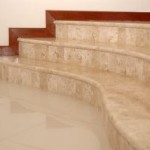Marble is a metamorphic rock. It is formed from limestone that has gone through a process of recrystallisation through heat or pressure. This gives it a dense crystalline structure that makes a polished surface possible.
 Marble tiles could be used and installed in bathrooms, hallways, pathways, and in many other home locations. One common use for marble tiles is for the flooring. Like all stone, marble is both heavy and brittle. When these factors are combined with poor handling or internal weakness, the marble is liable to break.
Marble tiles could be used and installed in bathrooms, hallways, pathways, and in many other home locations. One common use for marble tiles is for the flooring. Like all stone, marble is both heavy and brittle. When these factors are combined with poor handling or internal weakness, the marble is liable to break.
Marble can also be damaged if it is exposed to acids and strong alkalis. Apart from distilled water, the solvents mentioned below are all listed on the COSHH (Control of Substances Hazardous to Health) Register. It is very important to read the instructions and hazard labels before you use these .
– Distilled water – available from DIY stores and chemists, used to clean and as a neutral rinse.
– White spirit – good for removing waxes and oily dirt, available from DIY and hardware stores.
– 2% non-ionic detergent – available from chemists.
Gloves (plastic or Nitrile, not fabric) should be worn to protect the hands, work should be carried out in a very well ventilated area, and the minimum amount of solvent should be used.
To ensure safe handling of solvents, decant small quantities for use into glass or ceramic containers – this prevents contaminating your bulk supply. Label small quantities of solvent (use the bulk container as a guide) and store all solvents appropriately (e.g. out of reach of children and away from sources of ignition etc.).
Avoid using bleach on marble: it does not remove stains and may change its colour or chemically react to fix the stain permanently. Bathroom cleaners often contain harsh abrasives, are acidic (to help remove limescale) and have a range of additives designed to improve their cleaning performance. Spray cleaners have similar ingredients.
All proprietary cleaners of this type can damage marble, and can ‘skin’ the surface, which will then be visible as dull patches. Polishing with abrasives may increase the sheen, but also removes the surface of the marble, damaging pieces of historical or monetary value.
Although it seems like hard work, marble creates a very elegant, sophisticated and classy look to your home, office or any particular room in any building. It is certainly worth the extra effort spent on its maintenance!
